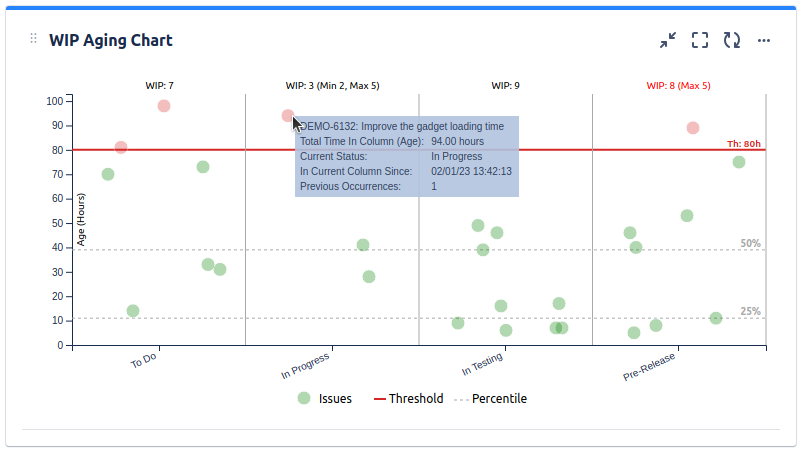You may be experiencing slow load times on the forum; the team is working to resolve this ASAP.
×Community resources
Community resources
- Community
- Q&A
- Jira Service Management
- Questions
- Can I see all issues in a control chart instead of just clusters or outliers
Can I see all issues in a control chart instead of just clusters or outliers

Hello,
I am trying to track days issues are spent in a column. I can see dots when I look at a board view but where do I find that info in reports. The control chart seems to have what I need however the dots it shows me do not show all of the issues. I would like to look at all of the issues. Is there a way to show that. Thanks!
3 answers
Hi @Ash Viceer,
Try our Great Gadgets app.
One of the many gadgets that is offers, is a Control Chart gadget that displays all the issues in the chart.

But, if you want to see how long an issue stayed in a board column or status, I think is better to use the WIP Aging Chart gadget.

Both gadgets offer a Data tab where you can see all the issues along with their cycle time or age.
If you have questions, please don't hesitate to contact support@stonikbyte.com.
Thank you,
Danut M.
Hi @Ash Viceer
As an alternative, you can try Status Time Reports app developed by our team. It mainly provides reports and gadgets based on how much time passed in each status.
Here is the online demo link, you can see it in action and try without installing the app.
- This app has a dynamic status grouping feature so that you can generate various valuable reports as time in status, time in assignee, status entry dates and status counts, cycle time and lead time, average/sum reports by any field(e.g. average in progress time by project, average cycle time by issue creation month).
- You can search issues by Project, Issue Type, Status, Assignee, Issue Creation/Resolution Date(and any other Date field) and JQL Query.
- Status durations are calculated according to the working calendar you define. Once you enter your working calendar into the app, it takes your working schedule into account too. That is, "In Progress" time of an issue opened on Friday at 5 PM and closed on Monday at 9 AM, will be a few hours rather than 3 days.
- You can set different duration formats.
- You can export reports in CSV file format and open them in MS Excel.
- You can also add this app as a gadget to your Jira dashboards and reach “Status Time” from Issue Detail page.
- You can enable/disable access to Status Time reports&gadgets and Issue Detail page per project, users, groups or project role.
If you are looking for a free solution, you can try the limited version Status Time Free.
Hope it helps.
You must be a registered user to add a comment. If you've already registered, sign in. Otherwise, register and sign in.
Hello @Ash Viceer,
Jira's Control Chart offers limited details and flexibility in terms of report parameters. The dots in the board view are also not very precise. For maximum details and flexibility, you should use a marketplace app.
If you are OK with using a marketplace app for this, our team at OBSS built Timepiece - Time in Status for Jira for this exact need. It is available for Jira Server, Cloud, and Data Center.
Time in Status mainly allows you to see how much time each issue spent on each status.

Time in Status reports can be accessed through its own reporting page, dashboard gadgets, and issue view screen tabs (also available on issue details views on board view). All these options can provide both calculated data tables and charts.
The app has Consolidated Columns feature. This feature allows you to combine the duration for multiple statuses into a single column and exclude unwanted ones. It is the most flexible way to get any measurement you might want. Measurements like Issue Age, Cycle Time, Lead Time, Resolution Time etc.
For all numeric report types, you can calculate averages and sums of those durations grouped by the issue fields you select. For example total in-progress time per customer (organization) or average resolution time per sprint, week, month, issuetype, request type, etc. The ability to group by parts of dates (year, month, week, day, hour) or sprints is particularly useful here since it allows you to compare different time periods or see the trend.
The app calculates its reports using already existing Jira issue histories so when you install the app, you don't need to add anything to your issue workflows and you can get reports on your past issues as well. It supports both Company Managed and Team Managed projects for Jira Cloud.

Timepiece - Time in Status for Jira
EmreT
You must be a registered user to add a comment. If you've already registered, sign in. Otherwise, register and sign in.



You must be a registered user to add a comment. If you've already registered, sign in. Otherwise, register and sign in.